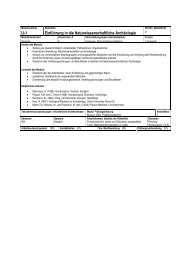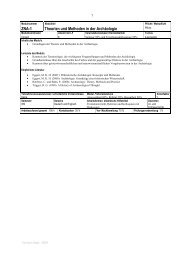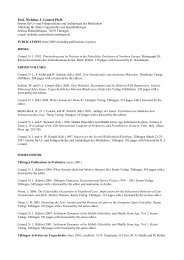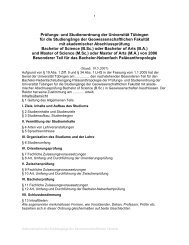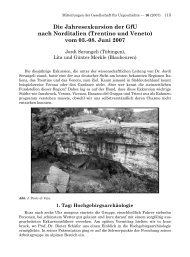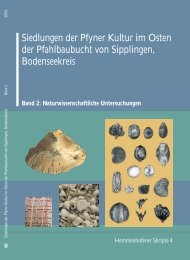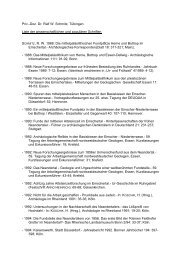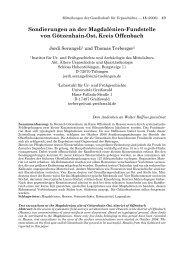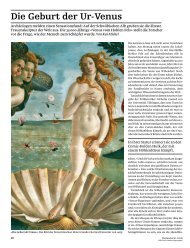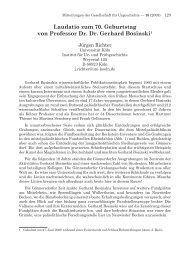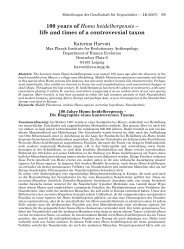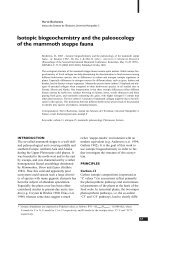bronze age environment and economy in the troad - Universität ...
bronze age environment and economy in the troad - Universität ...
bronze age environment and economy in the troad - Universität ...
Create successful ePaper yourself
Turn your PDF publications into a flip-book with our unique Google optimized e-Paper software.
chapter 1: <strong>environment</strong> <strong>and</strong> archaeology<br />
Troy I<br />
Troy II<br />
Troy III<br />
Troy IV<br />
Troy V<br />
Troy VI<br />
Schliemann (1871) - Dörpfeld (1893) - Korfmann <strong>and</strong> Rose (1988)<br />
Blegen <strong>and</strong> Sperl<strong>in</strong>g (1932)<br />
‛fortress’ type<br />
10 (a-j) architectural phases<br />
‛rectangular megaron’<br />
dark monochrome burnished ware, Urfirnis, stylised<br />
human facial features<br />
Aegean imports (sauceboat)<br />
sp<strong>in</strong>dle whorls <strong>and</strong> loomweights from terracotta<br />
strongly represented<br />
destruction by fire<br />
eight architectural phases<br />
fortification walls are extended<br />
Megaron IIA<br />
more of <strong>the</strong> pottery red to tan <strong>in</strong> colour <strong>in</strong>stead of black,<br />
depas amphikypellon, fast wheel<br />
high level of textile production<br />
gold <strong>and</strong> silver<br />
enormous prosperity, wide extent of contacts (Aegean<br />
<strong>and</strong> also <strong>in</strong> <strong>in</strong>l<strong>and</strong> Turkey)<br />
two destruction horizons, caused by fire: beg<strong>in</strong>n<strong>in</strong>g (IIa)<br />
<strong>and</strong> end (IIg)<br />
small one-to three-roomed houses grouped <strong>in</strong> larger<br />
complexes<br />
animal figur<strong>in</strong>es from terracotta<br />
end of Troy III is marked by a demolition for unknown<br />
reasons<br />
houses are built of mudbrick on a stone socle aga<strong>in</strong><br />
domed oven is <strong>in</strong>troduced at <strong>the</strong> beg<strong>in</strong>n<strong>in</strong>g of <strong>the</strong> period<br />
Most of <strong>the</strong> vases are wheel-made<br />
demolition for unknown reasons<br />
three to four architectural phases (Blegen)<br />
pottery not dist<strong>in</strong>guishable from Troy IV<br />
eight sub-phases<br />
wall of more than four meters thickness <strong>and</strong> n<strong>in</strong>e meters<br />
height<br />
numerous pithoi, sharp break <strong>in</strong> <strong>the</strong> ceramic tradition<br />
between Troy V <strong>and</strong> Troy VI, ‛Grey M<strong>in</strong>yan’, Mycenaean<br />
pottery locally imitated<br />
Megara, half-timber<strong>in</strong>g an alternative build<strong>in</strong>g style<br />
cemetery of cremation burials<br />
walls were destroyed at <strong>the</strong> end of Troy VI, thought to<br />
be an earthquake<br />
layer older than Troy I<br />
contemporaneity of late horizons of Troy I with<br />
early strata from Troy II<br />
‛Megaron’ turns out to be a sequence of jo<strong>in</strong>t long<br />
houses<br />
“Troy II rema<strong>in</strong>s orig<strong>in</strong>ate from an elite, while<br />
common people were liv<strong>in</strong>g outside <strong>the</strong> citadel<br />
cont<strong>in</strong>u<strong>in</strong>g to practice Troy I traditions”<br />
houses outside <strong>the</strong> Troy II fortification wall<br />
multiphase gate structure<br />
Troy III still belongs to <strong>the</strong> same l<strong>in</strong>e of development<br />
<strong>in</strong> terms of ceramic production as Troy I <strong>and</strong><br />
II<br />
rema<strong>in</strong>s of megara type build<strong>in</strong>gs, an ‛Anatolian<br />
settlement scheme’<br />
significant evidence for <strong>the</strong> importance of <strong>the</strong> Middle<br />
Bronze Age settlement<br />
<strong>the</strong> walls of Troy IV could have extended far outside<br />
<strong>the</strong> citadel walls of Troy VI<br />
six conflagrations <strong>in</strong> succession<br />
circumference of <strong>the</strong> Troy VI Lower City is<br />
uncovered<br />
stone foundations imply that a settlement outside<br />
<strong>the</strong> citadel was planned from <strong>the</strong> beg<strong>in</strong>n<strong>in</strong>g<br />
evidence of wholly new architectural plans <strong>and</strong><br />
structures <strong>in</strong> Troy VI: a completely new population<br />
houses with solid foundations, less stable oval-or<br />
apsidal houses, post-or pillar build<strong>in</strong>gs <strong>in</strong>terpreted<br />
as reflect<strong>in</strong>g social differences with<strong>in</strong> <strong>the</strong> population<br />
high population density <strong>in</strong> Late Bronze Age<br />
f<strong>in</strong>ds of long-range weapons as argument aga<strong>in</strong>st a<br />
destruction of <strong>the</strong> city by an earthquake<br />
13



